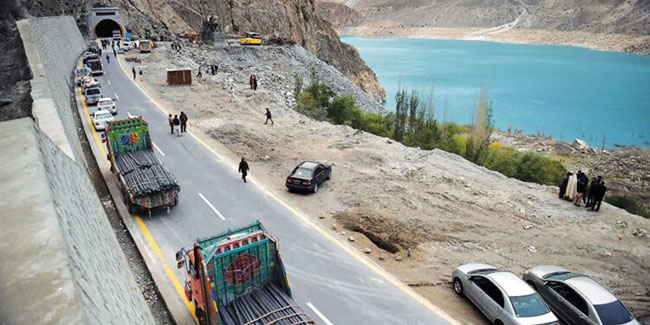Balochistan, Pakistan’s largest and most resource-rich province, covers 347,190 square kilometers in the country’s southwest.
Bordered by Iran, Afghanistan and the Arabian Sea, this strategically located region possesses abundant natural resources, including natural gas, coal, copper and gold.
Yet, despite its immense potential, Balochistan remains the least developed province, plagued by poverty, lack of educational opportunities, poor healthcare infrastructure and a prolonged sense of political and economic marginalization.
Despite the challenges, Balochistan stands at a crossroads today—with a new window of opportunity emerging in the form of the China-Pakistan Economic Corridor (CPEC).
CPEC, a flagship initiative under China’s Belt and Road Initiative (BRI), envisions transformative infrastructure and energy development across Pakistan.
At the heart of this corridor lies Gwadar Port, a deep-sea port situated in Balochistan that connects western China to the Arabian Sea, offering a shorter trade route to the Middle East and Africa.
For Balochistan, CPEC is more than a geo-economic project—it is a lifeline that can drive inclusive growth, promote connectivity and bridge long-standing developmental gaps.
The development of Gwadar Port, improvement of road and rail networks and construction of energy infrastructure are already laying the foundation for regional integration.
These investments have the potential to create jobs, attract industries and elevate local standards of living.
However, for this potential to be fully realized, it is essential that the people of Balochistan become genuine stakeholders in the CPEC vision.
Historically, one of the most recurring grievances of Baloch residents has been the perceived exploitation of their natural wealth without corresponding benefits.
CPEC offers an opportunity to correct this imbalance—if approached with sensitivity, transparency and inclusivity.
First and foremost, local communities must be included in decision-making processes concerning development projects.
The sense of alienation often stems from a lack of consultation and representation.
Ensuring that local voices are heard and respected can help build trust between the center and the province.
Second, infrastructure development under CPEC must go hand-in-hand with investments in education, healthcare and human resource development.
Establishing vocational training centres, modern schools and healthcare facilities in and around Gwadar and other key areas will enable the local population to directly benefit from the opportunities created.
Equipping Baloch youth with relevant skills will reduce unemployment and prevent the province’s economic marginalization.
Third, it is crucial to address security concerns not merely through force, but through political dialogue and reconciliation.
While state security is vital, peace in Balochistan cannot be achieved solely through military means.
A people-centric approach—centered on justice, accountability and the rule of law—is essential to counter narratives of disenfranchisement.
Ending practices such as enforced disappearances, ensuring fair trials and upholding human rights can go a long way in fostering a more stable environment conducive to development.
Fourth, resource management must reflect fairness and equity.
While Balochistan is rich in natural resources, the locals often see little return from their exploitation.
Establishing transparent mechanisms for resource revenue-sharing, supporting local enterprise and promoting small and medium-sized businesses can change this narrative.
CPEC’s focus on Special Economic Zones (SEZs) can be harnessed to empower local entrepreneurs, reduce poverty and promote industrial growth.
The success of CPEC in Balochistan is vital not just for the province but for Pakistan’s broader economic and strategic future.
A stable and prosperous Balochistan will attract foreign investment, strengthen national unity and enhance regional connectivity.
On the global stage, Gwadar’s transformation into a trade and logistics hub can redefine Pakistan’s economic geography, placing it at the centre of transcontinental trade routes.
It is worth noting that several CPEC projects are already contributing to local development.
The Gwadar East Bay Expressway, Gwadar Free Zone and the New Gwadar International Airport are creating new economic possibilities.
Furthermore, Chinese investment in energy and infrastructure is helping to address Pakistan’s long-standing issues of power shortages and transport bottlenecks.
These initiatives must now be extended and deepened with a strong focus on inclusion.
The people of Balochistan have endured decades of neglect, but they have not given up on the hope of a better future.
CPEC provides a real chance to turn that hope into reality.
However, this cannot happen without political will, sincerity and a shift in governance priorities.
Rather than viewing the province as a security risk or a peripheral territory, it must be embraced as a core part of the national development agenda.
The road to peace and prosperity in Balochistan lies in partnership, not paternalism.
It lies in empowering people rather than policing them.
And most importantly, it lies in recognizing that projects like CPEC are not just about roads and ports—they are about lives, livelihoods and the promise of shared progress.
If implemented with vision and inclusivity, CPEC can be the bridge that finally connects Balochistan to the prosperity it has long been denied.
It is time to seize this opportunity—not only for Balochistan’s future but for the future of Pakistan as a whole.


















